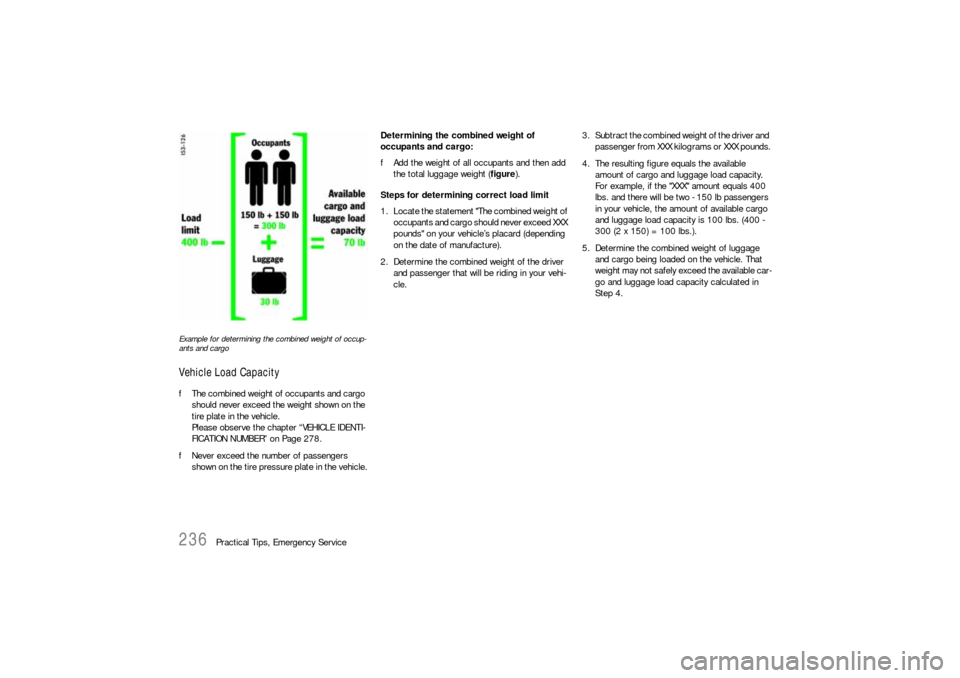Page 230 of 296

230
Practical Tips, Emergency Service
Wheel alignment, wheel balancing As a precaution, have wheels with summer tires
balanced in the spring, and those with mud and
snow tires before winter.
Unbalanced wheels may affect car handling and
tire life.
Only the specified weights may be used for wheel
balancing.
Self-adhesive weights must not come into contact
with cleaning agents, since they could drop off.
Uneven tread wear indicates wheel imbalance. In
this event, the vehicle should be checked at an au-
thorized Porsche dealer.
Warning!
If, during a journey, uneven running or vibra-
tions occur that could be caused by damage
to tires or the car, the speed must be re-
duced immediately, but without braking
sharply.
If you continue your trip without having the
cause of the fault remedied, you might lose
control of your vehicle which could cause se-
vere personal injury.
fStop the vehicle and check the tires.
fIf no cause for the fault can be found, drive
carefully to the nearest authorized Porsche dealer.
Removing and storing tires fAfter changing, adjust tire pressure and torque
wheel bolts diagonally to 94 ftlb (130 Nm).
Tires must always remain on the same side of
the vehicle.
When wheels are removed, the direction of
rotation and position of each wheel should be
marked.
Example
FR (front right), FL, RR and RL.
Wheels must always be fitted in accordance with
their marking.
The preception that tire durability and perform-
ance are immune to the effects of storage and
age is unfounded.
Chemical additives, which make the rubber elas-
tic, lose their effectiveness in the course of time
and the rubber becomes brittle and cracks.
Therefore, the tires should be inspected from
time to time. Note
Under no circumstances should tires older than 6
years be used on your Porsche.
The age of the tire can be obtained from the “DOT”
code number. If, for example, the last four num-
bers read 1204, then the tire was produced in the
12th week of 2004.
fStore tires in a cool and dry place.
Page 235 of 296

Practical Tips, Emergency Service
235
Loading InformationDefinitionsThe Curb weight - actual weight of your vehicle -
vehicle weight including standard and optional
equipment, fluids and emergency tools. This
weight does not include passengers and cargo.
The Gross Vehicle Weight is sum of the curb
weight and the weight of passengers and cargo
combined.
The Gross Vehicle Weight Rating is the maxi-
mum total weight of vehicle, passengers, luggage
and optional equipment.
The Gross Axle Weight Rating is the maximum
load limit for the front or the rear axle. This infor-
mation is located on the safety compliance sticker
located in the driver’s side door jamb.
For determining the compatibility of the tire and
vehicle load capabilities:
fPlease observe the chapter “TIRES, RIMS,
TRACKS” on Page 282.
The load capacity coefficient (e.g. “101”) is a min-
imum requirement.The Gross Combined Weight Rating is the
maximum total weight rating of vehicle, passen-
gers and cargo.
The Vehicle Capacity Weight - Load Limit - is
the maximum total weight limit specified of the
load (passengers and cargo) for the vehicle. This
is the maximum weight of passengers and cargo
that can be loaded into the vehicle. This informa-
tion can be found on the tire pressure plate.
The maximum loaded vehicle weight is the
sum of curb weight, accessory weight, vehicle ca-
pacity weight and production options weight.
The load rating is the maximum load that a tire
is rated to carry for a given inflation pressure.
The maximum load rating is the load rating for
a tire at the maximum permissble inflation pres-
sure.
The cargo capacity is the permissible weight of
cargo, the substracted weight of passengers from
the load limit.
fNever exceed the permissible limits.
Danger!
Risk of personal injury, loss of control and
damage to vehicle.
fNever exceed the specified axle loads. Over-
loading can shorten the service life of the tires
and car, as well as lead to dangerous vehicle
reactions and long braking distances. Damage
due to overloading is not covered by the vehi-cle warranty.
Page 236 of 296

236
Practical Tips, Emergency Service
Example for determining the combined weight of occup-
ants and cargoVehicle Load CapacityfThe combined weight of occupants and cargo
should never exceed the weight shown on the
tire plate in the vehicle.
Please observe the chapter “VEHICLE IDENTI-
FICATION NUMBER” on Page 278.
fNever exceed the number of passengers
shown on the tire pressure plate in the vehicle.Determining the combined weight of
occupants and cargo:
fAdd the weight of all occupants and then add
the total luggage weight (figure).
Steps for determining correct load limit
1. Locate the statement "The combined weight of
occupants and cargo should never exceed XXX
pounds" on your vehicle’s placard (depending
on the date of manufacture).
2. Determine the combined weight of the driver
and passenger that will be riding in your vehi-
cle.3. Subtract the combined weight of the driver and
passenger from XXX kilograms or XXX pounds.
4. The resulting figure equals the available
amount of cargo and luggage load capacity.
For example, if the "XXX" amount equals 400
lbs. and there will be two - 150 lb passengers
in your vehicle, the amount of available cargo
and luggage load capacity is 100 lbs. (400 -
300 (2 x 150) = 100 lbs.).
5. Determine the combined weight of luggage
and cargo being loaded on the vehicle. That
weight may not safely exceed the available car-
go and luggage load capacity calculated in
Step 4.
Page 272 of 296

272
Practical Tips, Emergency Service
Adjusting Headlights fPlease observe the chapter “REPLACING BUL-
BS” on Page 258.
Adjustment
The adjustment is made with the vehicle ready to
drive and the fuel tank completely filled.
The driver’s seat must be loaded by a person or a
165 lbs. (75 kg) weight and the tire pressures
must meet the prescribed values.
After being loaded, the car must be rolled a few
meters so that the suspension can settle.
For checking the headlight adjustment, the verti-
cal position of the cutoff of the lowbeam (see fig.)
has to be projected on a vertical screen (wall) in
distance of 24.6 ft. (7.5 m) from the front lens of
the headlamp.
The correct position of the cutoff is 2.0 in. (5 cm)
at 24.6 ft. or 7.5 m (0.4°) below a horizontal line,
x cm from ground to the center of the headlamp
lens. Lateral adjustment of the headlights should be
carried out at a specialist workshop with an optical
adjustment unit.
Distance
Visual aim shall be performed at not less than
24.6 ft. (7.5) m (this value is a rounded down con-
version from the 25-foot distance typical of field
aim using a screen). The 24.6 ft. (7.5 m) distance
is measured from the headlamp lens to the view-
ing screen.
Page 278 of 296

278
Vehicle Identification, Technical Data
Vehicle IdentificationWhen ordering spare parts or making inquiries,
please always quote the vehicle identification num-
ber. Vehicle data bankThe vehicle data bank is attached to the inside of
the ”Maintenance“ booklet.
It contains all important data about your car.
Note
This data bank cannot be re-ordered if it is lost or
damaged.
This label contains the following information:
1. Vehicle Identification No.
2. Type/Type description
3. Engine code/Transmission code
4. Paint No./Interior
Vehicle identification number In accordance with Federal Safety Regulations,
the vehicle identification number of your car is lo-
cated at the bottom left of the windshield frame
and can be seen from the outside.
The vehicle identification number is in the front lug-
gage compartment under the battery cover and at
the bottom left behind the windshield.
Removing the battery cover
fPlease observe the chapter “BATTERY” on
Page 249.
Safety compliance sticker The safety compliance sticker is your assurance
that your new Porsche complies with all applicable
Federal Motor Vehicle Safety Standards which
were in effect at the time the vehicle was manuf-
actured.
The sticker also shows the month and year of pro-
duction and the vehicle identification number of
your car (perforations) as well as the Gross Vehic-
le Weight Rating and the Gross Axle Weight Ra-
ting.
Page 285 of 296
Vehicle Identification, Technical Data
285
Driving Performance* * At DIN empty weight and half load, without performance-inhibiting extra equipment. Boxster Manual transmission Tiptronic S
Maximum speed
5-speed transmission
6-speed transmission159 mph/256 km/h
160 mph/258 km/h155 mph/250 km/h
Acceleration 0 – 60 mph 5.9 seconds 6.8 seconds
Acceleration 0 – 100 km/h (62 mph) 6.2 seconds 7.1 seconds
Boxster S Manual transmission Tiptronic S
Maximum speed 167 mph/268 km/h 162 mph/260 km/h
Acceleration 0 – 60 mph 5.2 seconds 6.0 seconds
Acceleration 0 – 100 km/h (62 mph) 5.5 seconds 6.3 seconds
Page 287 of 296

Vehicle Identification, Technical Data
287
Weights
Dimensions Boxster Manual transmission Tiptronic S
Empty weight (depending on equipment) 2855 lbs. to 3109 lbs. 2987 lbs. to 3208 lbs.
1295 kg to 1410 kg 1355 kg to 1455 kg
Maximum gross weight 3549 lbs./1610 kg 3649 lbs./1655 kg
Maximum axle load, front* 1709 lbs./775 kg 1709 lbs./775 kg
Maximum axle load, rear* 2017 lbs./915 kg 2017 lbs./915 kg
Boxster S Manual transmission Tiptronic S
Empty weight (depending on equipment) 2965 lbs. to 3153 lbs. 3053 lbs. to 3241 lbs.
1345 kg to 1430 kg 1385 kg to 1470 kg
Maximum gross weight 3594 lbs./1630 kg 3682 lbs./1670 kg
Maximum axle load, front* 1709 lbs./775 kg 1709 lbs./775 kg
Maximum axle load, rear* 2072 lbs./940 kg 2072 lbs./940 kg
*The maximum gross weight must not be exceeded.
Note: If additional accessories are installed, the useful load will be correspondingly less.
PAS M
Length 170.4 in./4329 mm
Width 70.9 in./1801 mm
Height 51.0 in./1295 mm 50.6 in./1285 mm
Wheelbase 95.1 in./2415 mm
Ground clearance 4.0 in./101 mm 3.7 in./95 mm
Turning circle 36.4 ft./11.1 m
Page 288 of 296
288Diagrams Acceleration diagram
Values have been determined at DIN empty
weight and with a 50 % load without
additional equipment.
Transmission diagram
The transmission diagram is based on
standard values on the basis of a mean
effective scrub radius. Changes of the scrub
radius, the tire tolerance, wear and tear,
deviating country equipment and tire slip
have not been taken into account.
Boxster S: Engine diagram at full power